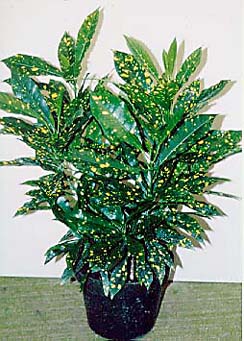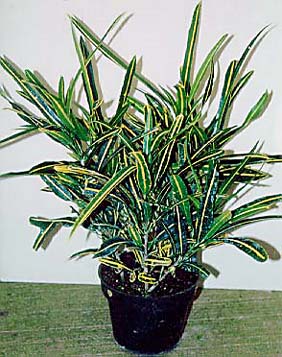|
Plants for your home
(By Mary Efanti)
Croton
 Origin
– Description Origin
– Description
Impressively colorful! This plant came from the exotic islands of the pacific
and Malaysia. It is a shrub with
fleshy leather-like leaves. The
leaves start out green but change colors as they mature.
The tones of the leaves are numerous and depending on the variety they
can be yellow to orange or red. Many
different colors exist on the same plant, a characteristic that makes crotons
unique plants.
Originally, its colorful leaves were used in cut flower
arrangements while croton as a houseplant became popular during the last decade. Its many varieties differ mainly in the appearance of the leaves that can
be long, flat, narrow or wide or even curly.
Care
Caring for a croton is not simple and requires both
knowledge and experience. Basic
prerequisites are plenty of light, suitable temperature, adequate watering and
plenty of humidity in the atmosphere.
To
start, crotons need plenty of light in order to
maintain its intense colors although new varieties do quite well in lower light.
Lots of light and moderate temperatures are the factors that will ensure
your plant has vivid colors and quick growth. In other
words, the more the light your plant gets, the more beautiful
and vivid the colors of its leaves. During
the winter you can allow some direct sunlight on your plant, but keep it at 2-3
hours daily. If more, then you will
risk sun-burning of the leaves while during summer you should only provide
filtered light.
Crotons cannot stand either too high or too low
temperatures (the ideal temperature is around 20C). So, make sure to avoid
fluctuations of temperature and keep the pots away from drafts.
If the temperature has such ups and downs you will see leaves, in
different parts of the plant, drop. Generally,
if the temperature is too low your plant may drop all of its leaves in no time.
If you notice lower leaves
dropping, or if the leaves
colors are dull and you also get brown tips, it is possible that your plant
needs more humidity.
Provide humidity by spraying the leaves with lukewarm
water as often as you can, even daily if you can spare the time. Use a humidifier or place the pot on a tray with wet pebbles so that the
plant will absorb the necessary humidity.
Usually during
summer, although light is more than adequate, the high temperatures may fade the colors of the
leaves. To avoid this, in summer move your pot to the coolest spot of your home
and cut down on fertilizing as over-fertilizing can have the same effects as
high temperatures. The growth of the plant slows down in winter, when the plant
rests, but the colors of its leaves remain as bright if light is
adequate.
You should fertilize every couple of
months, using
liquid fertilizer, from spring till fall while you should not add any fertilizer
during winter as the plant is resting.
 The soil should be light, containing lots of moss and
excellent drainage. You should
definitely add some perlite in the soil to maintain humidity as crotons need
plenty of water and will immediately wilt if its soil goes dry (it will of
course revive if you water in time). You
should water regularly, with plenty of water each time. Of
course, do not forget to empty the tray of the pot every time you
water in order to avoid root rot. Brown
tips could also indicate that the soil is too wet for too long. The soil should be light, containing lots of moss and
excellent drainage. You should
definitely add some perlite in the soil to maintain humidity as crotons need
plenty of water and will immediately wilt if its soil goes dry (it will of
course revive if you water in time). You
should water regularly, with plenty of water each time. Of
course, do not forget to empty the tray of the pot every time you
water in order to avoid root rot. Brown
tips could also indicate that the soil is too wet for too long.
Crotons like to be a little
pot-bound, so repot only
when the roots take up all the space and use a pot only one size larger. The best time to repot is early spring after the weather warms
up.
You can pinch the top growth in order to get a bushier
plant and control its shape. Prune
as often as you like and do not discard the cut parts because crotons propagate
easily through cuttings. A single
leaf can grow roots in water (first let it dry out and wait until the white sap
stops) and you can plant it as a brand new plant. Keep in mind, when pruning, that the white sap that comes out
of the cut parts is toxic and can irritate some people’s skin or stain fabrics.
 Although crotons are resistant to disease, it may be
eventually affected by scale are rarely by thrips. In case of scale infection, clean up its leaves thoroughly,
with special care on the underside of the leaves, with wet sponge and lukewarm
water. Then spray with a mixture of
lukewarm water with 2-3 drops of dishwashing liquid and blue alcohol if you wish
to use a non-chemical approach or you can get a special insecticide from any
nursery. Chemicals are usually too
toxic for indoor use and it is recommended that their use is avoided during
winter when the aeration of our homes is not satisfactory. Especially, if there are kids or pets at
home, prefer a non-toxic treatment. Although crotons are resistant to disease, it may be
eventually affected by scale are rarely by thrips. In case of scale infection, clean up its leaves thoroughly,
with special care on the underside of the leaves, with wet sponge and lukewarm
water. Then spray with a mixture of
lukewarm water with 2-3 drops of dishwashing liquid and blue alcohol if you wish
to use a non-chemical approach or you can get a special insecticide from any
nursery. Chemicals are usually too
toxic for indoor use and it is recommended that their use is avoided during
winter when the aeration of our homes is not satisfactory. Especially, if there are kids or pets at
home, prefer a non-toxic treatment.
Remember that healthy plants are less prone to insect
infections. The best way to prevent
such infections is to clean the leaves (both over and under of the leaves) often.
Besides their colorful
appearance, crotons are also a
challenge for all of us who love plants and wish to keep them pretty and healthy. Caring for the croton in your living room will definitely provide a
pleasant activity and will make your house look much prettier.
Mary Efanti
mefanti@otenet.gr
|
